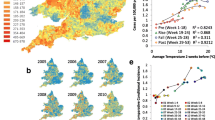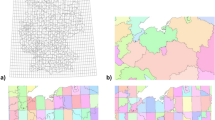Abstract
Campylobacter is among the most important agents of enteritis in developed countries. We have described the potential environmental determinants of the seasonal pattern of infection with campylobacter in Europe, Canada, Australia and New Zealand. Specifically, we investigated the role of climate variability on laboratory-confirmed cases of campylobacter infection from 15 populations. Regression analysis was used to quantify the associations between timing of seasonal peaks in infection in space and time. The short-term association between weekly weather and cases was also investigated using Poisson regression adapted for time series data. All countries in our study showed a distinct seasonality in campylobacter transmission, with many, but not all, populations showing a peak in spring. Countries with milder winters have peaks of infection earlier in the year. The timing of the peak of infection is weakly associated with high temperatures 3 months previously. Weekly variation in campylobacter infection in one region of the UK appeared to be little affected by short-term changes in weather patterns. The geographical variation in the timing of the seasonal peak suggests that climate may be a contributing factor to campylobacter transmission. The main driver of seasonality of campylobacter remains elusive and underscores the need to identify the major serotypes and routes of transmission for this disease.



Similar content being viewed by others
References
Altekruse SF, Stern NJ, Fields PI, Swerdlow DL (1999) Campylobacter jejuni—an emerging foodborne pathogen. Emerg Infect Dis 5:28–35
Blummer C, Roche P, Spence J et al (2003) Australia’s notifiable diseases status 2001: annual report of the National Notifiable Diseases Surveillance System. Commun Dis Intell 27
Brennhovd O, Kapperud G, Langeland G (1992) Survey of thermotolerant Campylobacter spp. and Yersinia spp. in three surface water sources in Norway. Int J Food Microbiol 15:327–338
Christensen LE, Evans MC, Waino M, Ethelberg S, Madsen H, Wegener HC (2003) Climate as a predictor of prevalence of Campylobacter spp. in humans and broilers in Denmark. In: The 12th International Workshop on Campylobacter, Helicobacter and Related Organisms, Aarhus, Denmark, September 2003
Clark CG, Price L, Ahmed R, Woodward DL, Melito PL, Rogers FG, Jamieson D, Ciebin B, Li A, Ellis A (2003) Characterization of water borne disease outbreak associated Campylobacter jejuni, Walkerton, Ontario. Emerg Infect Dis 9:1232–1241
de Wit MA, Hoogenboom-Verdegaal AM, Goosen ES, Sprenger MJ, Borgdorff MW (2000) A population-based longitudinal study on the incidence and disease burden of gastroenteritis and campylobacter and salmonella infection in four regions of the Netherlands. Eur J Epidemiol 16:713–718
Dowell SF (2001) Seasonal variation in host susceptibility and cycles of certain infectious diseases. Emerg Infect Dis 7:369–374
D’Souza RM, Becker N, Hall G, Moodie KB (2004) Does ambient temperature affect foodborne disease? Epidemiology 15:86–92
Duncanson M, Russell N, Weinstein P, Baker M, Skelly C, Hearnden M, Woodward A (2000) Rates of notified cryptosporidiosis and quality of drinking water supplies in Aotearoa, New Zealand. Water Res 34:3804–3812
Eberhart-Phillips EJ, Walker N, Garrett N, Bell D, Sinclair D, Rainger W, Bates M (1997) Campylobacteriosis in New Zealand: results of a case-control study. J Epidemiol Community Health 51:686–691
Health Canada (2003) Canadian integrated surveillance report: salmonella, campylobacter, pathogenic E. coli and shigella, from 1996 to 1999. Can Commun Dis Rep 29
Hearnden M, Skelly C, Eyles R, Weinstein P (2003) The regionality of campylabacteriosis seasonality in New Zealand. Int J Environ Health Res 13:337–348
Humphrey T, Henley A, Lanning DG (1993) The colonization of broiler chickens with Campylobacter jejuni: some epidemiological investigations. Epidemiol Infect 110:601–607
IID Study Team (2002) A report of the study of infectious intestinal disease in England. Stationery Office, London
Jones PD, Conway D (1997) Precipitation in the British Isles: an analysis of area-averaged data updated to 1995. Int J Climatol 17(4):427–438
Kapperud G, Aasen S (1992) Descriptive epidemiology of infections due to thermotolerant Campylobacter spp. in Norway, 1979–1988. Acta Pathol Microbiol Immunol Scand 100:883–890
Kovats RS, Edwards S, Hajat S, Armstrong B, Ebi KL, Menne B and Collaborating Group (2004) The effect of temperature on food poisoning: time series analysis in 10 European countries. Epidemiol Infect 132:443–453
Lacey R (1993) Food-borne bacterial infections. Parasitology 107:S75–S93
Lopez CM, Giacoboni G, Agostini A, Cornero FJ, Tellechea DM, Trinidad JJ (2002) Thermotolerant Campylobacters in domestic animals in a defined population in Buenos Aires, Argentina. Prev Vet Med 55:193–200
Menzel A (2000) Trends in phenological phases in Europe between 1951 and 1996. Int J Biometeorol 44:76–81
Mitchell TD, Hulme M, New M (2002) Climate data for political areas. Area 34:109–112
Nylen G, Dunstan F, Palmer SR, Andersson Y, Bader F, Cowden JM, Feierl G, Galloway Y, Kapperud S, Megraud K, Molbak K, Petersen LR, Ruutu P (2002) The seasonal distribution of campylobacter infection in nine European countries and New Zealand. Epidemiol Infect 128:383–390
Obiri-Danso K, Paul N, Jones K (2001) The effects of UVB and temperature on the survival of natural populations and pure cultures of Campylobacter jejuni, Camp. coli, Camp. lari and urease-positive thermophilic campylobacters (UPTC) in surface waters. J Appl Microbiol 90:256–267
Parker DE, Legg TP, Folland CK (1992) A new daily Central England temperature series, 1772–1992. Int J Climatol 12:317–342
Petersen LR, Nielsen EM, Engberg J, Dietz HH (2001) Comparison of genotypes and serotypes of Campylobacter jejuni isolated from Danish wild mammals and birds and from broiler flocks and humans. Appl Environ Microbiol 67:3115–3121
Rodrigues LC, Cowden JM, Wheeler JG, Sethi D, Wall PG, Cumberland P, Tompkins DS, Hudson MJ, Roberts JA, Roderick PJ (2000) The study of infectious intestinal disease in England: risk factors for cases of infectious intestinal disease with Campylobacter jejuni infection. Epidemiol Infect 127:185–193
Root T, Price J, Hall KR, Schneider SH, Rosenzweig C, Pounds JA (2003) Fingerprints of global warming on wild animals and plants. Nature 421:57–60
Savill MG, Hudson JA, Ball A, Klena JD, Scholes P, Whyte RJ, McCormick RE, Jankovic D (2001) Enumeration of Campylobacter in New Zealand recreational and drinking waters. J Appl Microbiol 91:38–46
Schmidt K, Tirado C (2001) Seventh Report on Surveillance of Foodborne Diseases in Europe 1993–1998. Federal Institute for Health Protection of Consumers and Veterinary Medicine, European Centre on Environment and Health, Berlin, Rome
Schorr H, Schmid H, Rieder HL, Baumgartner A, Vorkauf H, Burnens AP (1994) Risk factors for Campylobacter enteritis in Switzerland. Zentralbl Hyg Umweltmed 169:327–337
Skelly C, Weinstein P (2003) Pathogen survival trajectories: an eco-environmental approach to the modelling of human campylobacteriosis ecology. Environ Health Perspect 111:19–28
Southern JP, Smith RM, Palmer SR (1990) Bird attack on milk bottles: possible mode of transmission of Campylobacter jejuni to man. Lancet 336:1425–1427
SPSS (2003) SPSS version 12. SPSS, Chicago, Ill.
Stanley KN, Wallace JS, Currie JE, Diggle PJ, Jones K (1998a) The seasonal variation of thermophilic campylobacters in beef cattle, dairy cattle and calves. J Appl Microbiol 85:472–480
Stanley KN, Wallace JS, Currie JE, Diggle PJ, Jones K (1998b) Seasonal variation of thermophilic campylobacters in lambs at slaughter. J Appl Microbiol 84:1111–1116
STATA (2003) STATA 8.1. Stata, Tex.
Tam CC, Rodrigues LC, O’Brien S (2003) The study of infectious intestinal disease in England: What risk factors for presentation to general practice tell us about potential for selection bias in case-control studies of reported cases of diarrhoea. Int J Epidemiol 32:99–105
Tam CC, Rodrigues LC, O’Brien SJ (2004) Temperature dependence of campylobacter enteritis in England. International Conference on Emerging Infectious Diseases, Atlanta, Georgia, USA, February–March 2004
Wallace JS, Stanley KN, Currie JE, Diggle PJ, Jones K (1997) Seasonality of thermophilic Campylobacter populations in chickens. J Appl Microbiol 82:219–224
Wallace JS, Stanley KN, Jones K (1998) The colonization of turkeys by thermophilic Campylobacters. J Appl Microbiol 85:224–230
Wedderkopp A, Rattenborg E, Madsen M (2000) National surveillance of broilers at slaughter in Denmark in 1998. Avian Dis 44:993–999
Wedderkopp A, Gradel KO, Jorgensen JC, Madsen M (2001) Pre-harvest surveillance of campylobacter and salmonella in Danish broiler flocks: a 2-year study. Int J Food Microbiol 68:53–59
WHO (2004) Report of WHO Meeting on Climate and Foodborne Disease. WHO, Rome (in preparation)
Wilkinson P, Campbell-Lendrum D, Bartlett C (2003) Monitoring the health effects of climate change. In: McMichael AJ, et al. (eds) Climate change and health: risks and responses. WHO, Geneva
Acknowledgements
S. H., S. E., K. L. E. and S. K. were funded by the European Commission as part of the project Climate Change and Adaptation Strategies for Human Health (cCASHh) (EVK2-2000-00070). The authors would also like to thank: C. Tirado at the WHO Regional Office for Europe for help with obtaining the surveillance data; C. Koppe at DWD, Germany, for supplying meteorological data; M. Fleury at Health Canada for analysis of the Canadian health data; A. Maarouf at Environment Canada for Canadian meteorological data; Communicable Diseases Network Australia, National Notifiable Diseases Surveillance System for providing the data for notifications of campylobacterosis for the years 1991 to 2001 and the Queensland Department of Natural Resources and Mines for providing interpolated temperature data for the same years; At Health Protection Agency, I Gillespie for extracting and cleaning the England and Wales campylobacter surveillance data, and G. K. Adak for advice; C. McGuigan at the Scottish Centre for Infection and Environmental Health for the Scottish surveillance data; M. Baker at Environmental Sciences Research, for advice and provision of New Zealand surveillance data.
Author information
Authors and Affiliations
Corresponding author
Rights and permissions
About this article
Cite this article
Sari Kovats, R., Edwards, S.J., Charron, D. et al. Climate variability and campylobacter infection: an international study. Int J Biometeorol 49, 207–214 (2005). https://doi.org/10.1007/s00484-004-0241-3
Received:
Revised:
Accepted:
Published:
Issue Date:
DOI: https://doi.org/10.1007/s00484-004-0241-3




